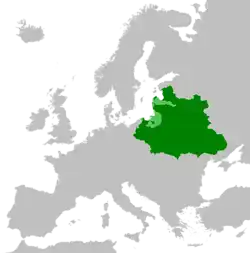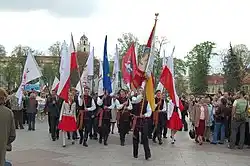
The Polish-Lithuanian Commonwealth was a large polity which existed in Eastern Europe between the sixteenth and eighteenth centuries. It came into existence following the Union of Lublin of 1569, which united the Kingdom of Poland and the Grand Duchy of Lithuania under one ruler, and survived down to 1795 when the Polish state ceased temporarily to exist as a result of the Partitions of Poland. The Commonwealth was one of the great powers of early modern Europe, one which covered modern-day Poland, most of the Baltic States region and much of what are now Belarus and Ukraine, while for a time it held territory in pockets of western Russia and Slovakia. There was considerable migration involved in the history of the Commonwealth. For instance, it was well established as a haven for Europe’s Jewish people to avoid persecution elsewhere in Christian Europe. The Union of Lublin also led to a gradual Polonization of Lithuania and the settlement of ethnic Poles in the Baltic States region. Finally, the dismantling of the Commonwealth through the Partitions of Poland provided the political background for the Polish diaspora of the nineteenth century.[1]
Research your ancestors on MyHeritage
The Polish-Lithuanian Commonwealth chronology of eventsThe Polish-Lithuanian Commonwealth chronology of events
The Kingdom of Poland emerged in the tenth century at the end of the Early Middle Ages as a Slavic kingdom on the edges of Roman Catholic Europe. It prospered in the centuries that followed and eventually emerged as one of Europe’s great medieval states, covering not just modern-day Poland but also further lands in Ukraine and Belarus which were conquered as the Mongol states that were established here late in the thirteenth century, declined in the fifteenth. The Grand Duchy of Lithuania emerged in the middle of the thirteenth century as part of the Lithuanian Crusade by the Teutonic Knights and the Livonian Order to extend Christian ruler over the Pagans of the Baltic States region. It had become a substantial power here, one which covered modern-day Lithuania and much of what are now Latvia, Estonia and the Kaliningrad Oblast by the sixteenth century, while also absorbing lands further east in Belarus south into Ukraine.[2]

The Union of Lublin of 1569 led to the formal creation of the Polish-Lithuanian Commonwealth as the Polish lords and those of the Grand Duchy of Lithuania agreed to have one ruler reign simultaneously as both King of Poland and Grand Duke of Lithuania going forward. This was the culmination of a gradual process whereby the rulers of the two realms had been entangled going all the way back to King Władysław II Jagiełło two centuries earlier. The first ruler of the newly formed Polish-Lithuanian Commonwealth in 1569 was King Sigismund II Augustus.[3]
The Commonwealth was one of the most substantial European states down to the early eighteenth century. It was one of the three powers, along with Russia and Sweden, which fought the Northern Wars (1558–1721) for hegemony over Northern and Eastern Europe and the Baltic Sea. It also played a crucial role in relieving the Great Siege of Vienna by the Ottoman Turks in 1683 and initiating a series of counterattacks against the Ottomans in the 1680s and 1690s.[4] Ultimately, though, the Commonwealth emerged as a loser in the Northern Wars, ceding extensive territory in the east of its realms to Russia. The country fell rapidly behind the other European powers politically, militarily, economically and socially in the course of the eighteenth century and fell prey to foreign meddling.[5] Over the course of the three Partitions of Poland in 1772, 1793 and 1795 the Commonwealth’s extensive territories were divided up between Prussia, Austria and Russia and in 1795 a Polish state ceased to exist. It would be another century and a quarter before a Polish state re-emerged following the First World War.[6]
Extent of migration associated with the CommonwealthExtent of migration associated with the Commonwealth
There were numerous different strands of migration associated with the history of the Polish-Lithuanian Commonwealth. One of the foremost concerned the Jewish people of Europe. The Kingdom of Poland had been well-established as a haven for Jewish people fleeing religious persecution in countries like England and France in Western and Central Europe since the thirteenth century. Indeed, when the Union of Lublin took place in 1569 the Kingdom of Poland was in the midst of a golden age of Jewish culture on cities like Warsaw and Krakow. The migration of Jewish people to the region as a religious and cultural haven continued in the era of the Commonwealth, with a sizeable number of Jews from Spain and Portugal continuing to arrive here as a result of expulsions and persecution in Iberia in the sixteenth and seventeenth centuries.[7]
Another manner in which the formation of the Commonwealth impacted on migration was in the gradual Polonization of some of the extremities of the state. Union increased the power of the already dominant Polish aristocracy, while over time Polish merchants and officials were placed in advantageous positions in places like the ports of Vilnius and Riga. Thus, Polish settlers unofficially colonized certain parts of the Grand Duchy of Lithuania and other regions of the Commonwealth.[8] Finally, the manner in which the Commonwealth declined rapidly in the eighteenth century and was then quickly done away with altogether through the Partitions of Poland provided the political context in which alienation from Prussian/German, Austrian and Russian rule in the nineteenth century would fuel the emigration of hundreds of thousands of Poles from the former lands of the Commonwealth.
Demographic impact of the Polish-Lithuanian CommonwealthDemographic impact of the Polish-Lithuanian Commonwealth

The demographic impact of these migratory patterns was immense. By the time of the Partitions of Poland in the late eighteenth century the Commonwealth was home to half of Europe’s Jewish people, a trend which still prevailed in Poland and Ukraine down to the Second World War. The settlement of Poles around the extensive lands of the Commonwealth between the late sixteenth and late eighteenth centuries paved the way for the emergence of sizeable Polish minorities in modern-day Lithuania, Latvia, Belarus and Ukraine. Finally, the manner in which the Commonwealth ended in the destruction of any Polish state and political domination by German and Russian powers between 1795 and 1918 was a major factor in the development of the Polish American community in the late nineteenth and early twentieth centuries, with hundreds of thousands of Poles heading to the Americas from the late 1840s onwards.[9]
See alsoSee also
Explore more about the Polish-Lithuanian CommonwealthExplore more about the Polish-Lithuanian Commonwealth
- Beginning Polish Genealogy at Legacy Family Tree Webinars
- Polish genealogy online – portals and databases at Legacy Family Tree Webinars
- Using MyHeritage to research Polish family history and to find living relatives in Poland at Legacy Family Tree Webinars
- Polish Communities – Migration and Resettlement at Legacy Family Tree Webinars
References
- ↑ https://www.thecollector.com/what-was-the-polish-lithuanian-commonwealth/
- ↑ Christopher Allmand, ‘The Kingdom of Poland and the Grand Duchy of Lithuania, 1370–1506’, in Aleksander Gieysztor (ed.), The New Cambridge Medieval History, Volume 7, c. 1415 – c. 1500 (Cambridge, 1998), pp. 727–747.
- ↑ Robert Ian Frost, The Union of Lublin, 1569 (Warsaw, 2019).
- ↑ https://polishhistory.pl/the-battle-of-vienna-1683-the-clash-that-saved-europe/
- ↑ https://www.worldhistory.org/Great_Northern_War/
- ↑ https://www.thecollector.com/partitions-of-poland-and-lithuania/
- ↑ https://yivoencyclopedia.org/article.aspx/Poland/Poland_before_1795
- ↑ Andrzej Wyrobisz, ‘Power and Towns in the Polish Gentry Commonwealth: The Polish-Lithuanian State in the Sixteenth and Seventeenth Centuries’, in Theory and Society, Vol. 18, No. 5 (September, 1989), pp. 611–630.
- ↑ J. Zubrzycki, ‘Emigration from Poland in the Nineteenth and Twentieth Centuries’, in Population Studies, Vol. 6, No. 3 (March, 1953), pp. 248–272.
